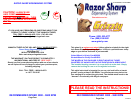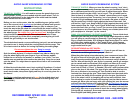
RAZOR SHARP EDGEMAKING SYSTEM
INSTRUCTIONS
TO INSTALL WHEELS: You will need to remove the guards from your
bench grinder, as they are not needed with this paper wheel. Then in-
stall the gritted wheel on the right side of the motor and the slotted
wheel on the left side of the motor.
Before you turn on the motor, take the conditioning wax (yellow stuff)
out of the cup and rub it sparingly on the black grit wheel until you can
see some wax on the grit. Then each time you start to sharpen, just
touch the wax to the grit wheel for a second with the motor running. The
wax has two functions; a) helps control heat & b) helps the grit stay on
the wheel longer. Be careful not to use too much wax, doing so will de-
stroy the effectiveness of the grit. There should be streaks of wax
(shiny) on the grit, but if the wax is completely covering the grit it will
reduce the grit’s ability to cut into the steel.
The slotted wheel needs no pre-conditioning just put it on and whenever
you start to use it, simply touch the running wheel with the rouge. This
is for heat control as well as for honing & polishing the cutting edge.
Do not over-tighten the nuts. Snug is enough.
Spin the wheels by hand. If a wheel wobbles from side to side try tap-
ping the wheel lightly with your fingers. If you still have a wobble,
loosen the nut and turn the washer, or washers, just a little. Turn one
washer one way and the other washer the other way. Snug the nut and
spin the wheel. You might have to repeat this a time or two to minimize
the wobble.
A little side to side deviation won’t hurt anything! Sometimes, if a wheel
is exposed to heat or dampness, it will warp a little. Place the wheel be-
tween two boards, clamp them tightly and keep in a cool dry place for a
few hours!
Grit Packs containing replacement grit, wax for the gritted wheel and
rouge for the slotted wheel can be purchased from www.grizzly.com
(Item #G5941).
RECOMMENDED SPEED 3000 - 3600
Page Two
RECOMMENDED SPEED 3000 - 3600 RPM
RAZOR SHARP EDGEMAKING SYSTEM
TRUING OF WHEELS: When you have the wheels running “true” don’t
remove them unnecessarily, because when you put them back they will
be in a different position and you will have to adjust them again. Some-
times the wheels may be a little “out of round”. The grit wheel can be
fixed at time of re-surfacing. If the “slotted” wheel seems out of round,
it can be trued at any time. Correcting “out of roundness” is easy. Take
a piece of 60 grit sandpaper and wrap it around a flat piece of metal (a
flat file works fine) & hold it lightly against the face of the wheel. You
will feel the “high” spot. Keep holding it lightly against the wheel until it
feels smooth. Now the “high” spot is gone & the wheel is clean & flat
across the face! Also you may “round” the corners of the slotted wheel
if you sharpen a lot of serrated knives. Simply use a folded piece of 60
grit sandpaper to “sharpen” up the corners.
OKAY, YOU ARE READY TO START SHARPENING: Time to think about
the angle you want on your knife or tool. Proper angle depends on what
you are going to use the edge for! Generally, if you are going to chop,
dig or scrape with a blade, a 35-40 degree angle works best. For razors
or a little rotary cutting wheel, a “flat” angle is best, 10-15 degrees.
Most knives are 20-25 degrees. You will learn with practice just what
angle works best for you.
RECONDITIONING the GRIT WHEEL:
Do not remove the wheel from the motor. If you do you will have to
eliminate the wobble again when you put it back on.
When the gritted wheel stops sharpening, use coarse sand paper (like
36 grit) to clean off all the grit, glue & wax down to bare paper. Just
wrap it around something hard & flat, like a crescent wrench handle or
flat file. After all the old grit, wax & glue is removed, use 60 grit sandpa-
per to smooth and true the wheel (as it might be a little out of round).
Next put some paper under the wheel to catch excess grit, & put an
even coat of Elmer’s (“Ross” in Canada) “Glue-All” multi-purpose white
glue on the face of the wheel. The layer of glue should not be too thin,
but not so thick as to be running off. You should be able to see the
laminate lines through the glue. Then slowly hand turn the wheel while
you sprinkle the black silicon carbide grit over the glue. Sprinkle the
grit on the wheel until it is sloughing off and no more will stick, then
turn the wheel a couple of times while tapping it on the side to remove
excess grit. When you are happy with your coating job, pour the excess
grit back into the container and replace the lid. Do not touch the wheel
until the glue dries completely, preferably for about 24 hours. Then it is
ready to go again. If there is a small nodule on the wheel, wait until the
glue is dry, then turn on your motor & touch the running wheel slightly
with the 60 grit sandpaper. Some users have successfully used Tite-
Bond Original (red label) glue as well.




